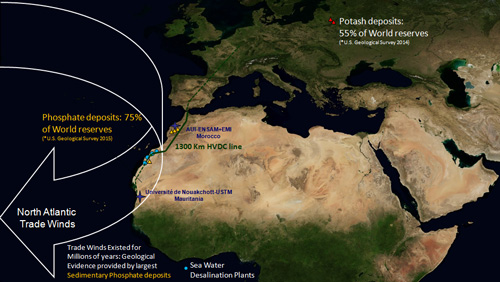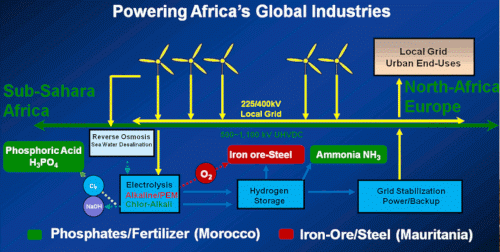The saturation of Africa’s larger electricity grids by wind power projects will lead to grid stability problems and confirm the need to adopt a better suited, integrated approach to wind developments. Because this region is located on the edge of one of the largest electricity grids (that of the EU), its vast renewable energy potential could be used to produce significant amounts of wind energy. Generated at competitive costs, these could ultimately end-up supplying broader electricity markets. This, however, will require an effect of scale. Building capacity to progressively firm these intermittent energy sources locally is an imperative first step on the critical path of major alternative, sustainable energy developments.
Besides large-scale transfer of electricity utilizing the High Voltage Direct Current line of the Sahara Wind Project, local mechanisms for accessing renewable energies are needed to support energy-intensive industries. These could ultimately lead to the emergence of low-carbon industries dissociated from fossil fuels, relying instead on wind-electricity and energy storage technologies. Renewable hydrogen, for instance, generated through wind-electrolysis, can be integrated into the processing of significant local iron-ore and phosphates deposits to produce CO2-free steel and fertilizers. In supporting local energy intensive industries, cleaner technologies introduced through pilot projects could be gradually expanded over Morocco and Mauritania’s wider trade windblown region. When electricity and hydrogen are simultaneously co-generated through industrial synergies, no CO2 emissions are emitted. Used mostly in the hydrocarbon upgrading and fertilizer industries with significant potential in decarbonizing steel production (responsible for 8% of global CO2 emissions), over 95% of the world’s hydrogen production is currently derived from fossil fuel reforming. This Process emits at least 7 tons of CO2 per ton of hydrogen produced. This represents a significant environmental challenge, particularly when deep decarbonization and hydrogen-mobility perspectives are taken into consideration. Industrial hydrogen for the synthesis of Ammonia used in the upgrading of fertilizers, for instance, consumes over 2% of the world's energy.

As Morocco holds approx. 70% of the world's phosphate reserves -of which 90% are used in fertilizer industries- the development of sustainable hydrogen production technologies open new perspectives in harnessing intermittent renewable energies. Key to world food security, fertilizer production through wind-electrolysis will be essential to access wind power. By providing storage and flexibility to fluctuating energy inputs, the functioning of the region’s weaker electricity grids will be enhanced. These technologies, currently tested within green campus concepts, are deployed regionally at partnering Universities of the ‘Sahara Trade Winds to Hydrogen' Project. Together with Morocco, Germany is now developing the first green hydrogen industrial plant in Africa.
It may be sensible to mention that wind-electrolysis for hydrogen production is modular. It enables the integration and storage of wind electricity at higher penetration rates through small distributed as well as large industrial applications. The latter represent the most promising route for accessing renewable energy and sustainable development objectives. They would indeed facilitate a more inclusive, cleaner processing of natural resources. Besides efficiency gains, the value-added derivatives generated through industrial synergies provide significant economic gains to the region.
The development of a wind industry to service the energy needs of mineral processes could, thanks to the availability of local resources, be replicated on a very large scale in the trade windblown coastline of the Sahara Desert. Renewable hydrogen generated as a by-product, is likely to reinforce the integration of wind electricity, which prior to any export considerations, remains the key objective of the Sahara Wind Project. The latter will also improve the operational balancing of Sahara Wind's HVDC line.




